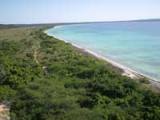Saturday, April 20, 2024
News and Views from the Global South

Tourism Threatens Natural Treasure
- A unique natural and geological site in the Dominican Republic hangs in the balance in the debate between ecotourism and major hotel expansion.
Tourism interests, focused on “all-inclusive” hotels, have set sights on the white-sand beaches and clear waters of this part of the Dominican Republic.
Located in the southwest province of Pedernales, bordering Haiti, Jaragua National Park is the Antilles’ area of greatest biodiversity. Its 1,374 square kilometers encompass forests, beaches and islands.
It has endemic species, like the rhinoceros iguana (Cyclura cornuta) and Ricord’s iguana (Cyclura ricordi), in danger of extinction. Since November 2002 the park has been one of three core areas in the biosphere designated by UNESCO, along with the Lago Enriquillo and Sierra de Bahoruco parks.
This is where the world’s smallest reptile was discovered, the Jaragua sphaero, or dwarf gecko (Sphaerodactylus ariasae), measuring just 16 millimeters.
On the Jaragua park’s beaches, sea turtles come to lay their eggs, like the hawksbill (Eretmochelys imbricata) and the leatherback (Dermochelys coriacea), and it is an important habitat to the freshwater turtle, the Hispaniola slider (Trachemys decorata), also endangered.
The name “Jaragua” comes from the language of the Taíno Indians, for whom the area was part of the Xaraguá Chiefdom. It is the only protected portion of the geological formation known as the Southern Paleoisland, one of the two that united 20,000 to 30,000 years ago to form what is now Hispaniola (Haiti and Dominican Republic).
The Sierra de Bahoruco, the mountain range that covers the entire park and extends to Haiti, was a separate formation, which explains why it holds so many endemic species and has served as a center for propagation and spread of plants and animals across the Antilles, say experts.
Aguilas Bay, a pristine seven-kilometer beach on the west coast of the park, has repeatedly attracted foreign firms interested in tourism development.
The government is considering some proposals. Since April it has been evaluating a plan from a Canadian mining company, whose name has not yet been divulged, to invest 850 million dollars in the construction of two hotels with golf courses in Pedernales, very close to Jaragua Park.
The project would be in Cabo Rojo, a few kilometers from Aguilas Bay, the tourism deputy secretary for the southern zone, José Altagracia Santana, told Tierramérica.
Although it is not part of the park, Cabo Rojo does form part of the same ecosystem and is within the biosphere reserve protected by UNESCO (United Nations, Educational, Scientific and Cultural Organization).
“Before any evaluation, the companies interested in building hotels are required to present an environmental impact study that includes all the elements established under Law 64-00,” Joselin Livian, deputy secretary for environment and natural resources in the neighboring province of Barahona, told Tierramérica.
Also in Cabo Rojo, bauxite mining is being developed by the Sierra Bauxita Dominicana firm. A huge mining and port complex has transformed the landscape and blue seas, and has displaced the sea turtles that used to lay eggs there.
In order to protect the turtles in Cabo Rojo and the park’s beaches from threats, the Jaragua Group, the most active environmental organization in the area, works to prevent the eggs from being stolen and to stop the capture of the turtles themselves for their prized shells.
But tourism is another story. “The impact of a great number of tourists would not only threaten the endemic species in these areas, but the entire ecosystem, which is unique in the world,” director of the Jaragua Group, Yvonne Arias, told Tierramérica.
Tourism is the second leading source of revenue for this Caribbean country, which has 676 hotels, receiving some eight million visitors in 2007-2008, according to figures from the Central Bank. The Dominican Republic’s own population is 9.5 million.
“It is necessary to foment the development of environmentally friendly local microenterprises and infrastructure for an equitable use of these areas, which includes the local population that is otherwise excluded from the benefits generated by ‘all-inclusive’ tourism,” said Arias.
Sustainable ecotourism could be a strategy to develop this province, where more than 60 percent of the households are poor.
In Pedernales, mortality for children five and under is 38 percent, while chronic malnutrition affects 15 percent of young children between the ages of six months and 59 months – five percentage points higher than the national average, according to the National Bureau of Statistics.
Unemployment among young adults is also a serious problem, at a rate of 30 percent among people 15 to 24 years old.
Empowering the local population and institutions is among the strategies to promote nature conservation in the area.
That is the aim of the Araucaria-Enriquillo Project, under way since 1999 with support from Spain’s international development cooperation agency, which is working in several parts in the south of the Dominican Republic to strengthen government management of sustainable development in the biosphere reserve.

 Print
Print




